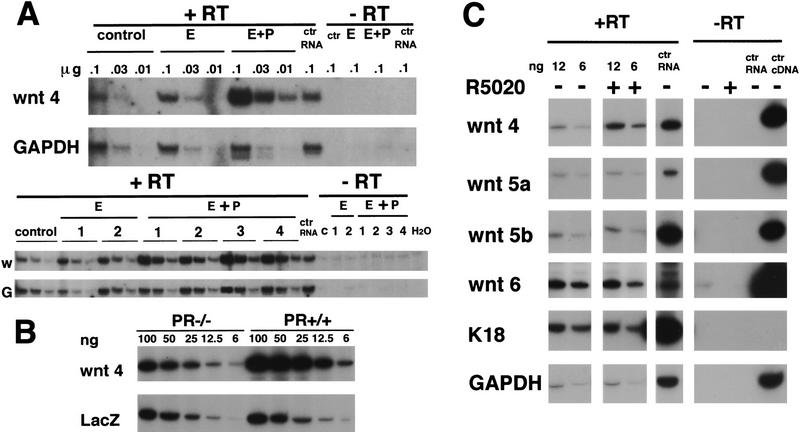Figure 5.
Induction of Wnt-4 expression in the mammary epithelium in vivo and in vitro by progesterone. (B) Quantification of Wnt-4 mRNA expression by semiquantitative PCR in mammary glands after 20 days of hormone treatment. Ten week-old virgin mice were ovarectomized. After 3 weeks they were injected for 20 days either with vehicle only (control), 10 μg of 17-β-estradiol (E)/day or 10 μg of estradiol and 100 μg of progesterone (E+P)/day. Total RNA was prepared from individual mammary glands, and samples in three serial dilutions, to ensure a linear signal response, were subjected to RT–PCR with primers specific for Wnt-4 or GAPDH. The same amounts of RNA in three serial dilutions were analyzed in each case. The undiluted RNA subjected to PCR amplification yielded no signal. Shown are two independent experiments, one comprising three mice (top) and one comprising seven mice (bottom). The products were quantified by densitometric scanning. The ratio of Wnt-4/GAPDH of the progesterone-treated samples was three- to fivefold higher than the 17-β-estradiol-treated samples. (B) Wnt-4 mRNA expression in mammary glands engrafted with PR−/− or PR+/+ mammary epithelium. Mammary epithelium was harvested from PR−/− ROSA26 and PR+/+ ROSA26 10-week-old female mice and engrafted to the cleared fat pads of 3-week-old F1 (129SV/C57B16) recipients. Six weeks after surgery the recipients were mated and the engrafted mammary glands were harvested at day 12 of pregnancy. RNA samples in five serial dilutions were subjected to RT–PCR with primers specific for Wnt-4 as in A. In parallel, RT–PCR was performed with lacZ-specific primers allowing normalization of the amount of transplanted epithelium. Densitometry reveals that the Wnt-4 signal is increased threefold in the PR−/− ROSA26 vs. the PR+/+ ROSA26 transplant. The same results were obtained in three independent experiments. (C) Wnt-4 mRNA expression in cultured primary mammary epithelial cells after progesterone exposure. Primary mammary epithelial cells were cultured on collagen-coated dishes for 3 days. RNA was harvested from untreated cells and cells after 8 hr of stimulation with the progesterone agonist R5020 (20 nm) (P). Shown are two out of five serial dilutions of RNA subjected to RT–PCR with primers specific for Wnt-4, Wnt-5a, Wnt-6, keratin-18, and GAPDH. In each case, the undiluted RNA subjected to PCR ampliification without reverse transcription yielded no signal. Although the levels of Wnt-5a, Wnt-5b, Wnt-6, keratin-18, and GAPDH mRNA were unaffected by the treatment with R5020, the levels of Wnt-4 mRNA increased two- to threefold within 4–8 hours as confirmed in eight independent experiments.

